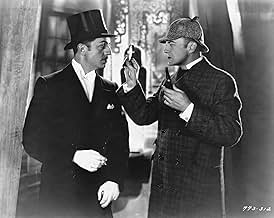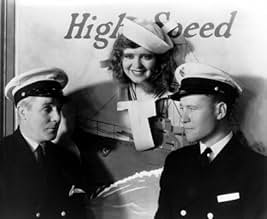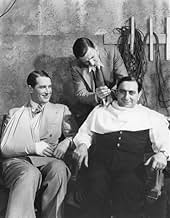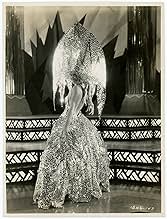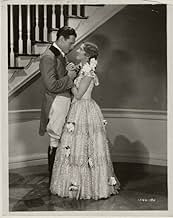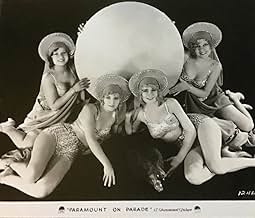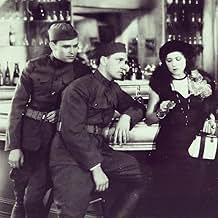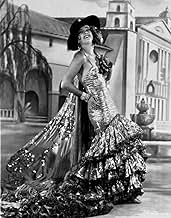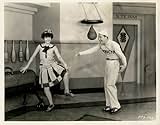अपनी भाषा में प्लॉट जोड़ेंA musical revue that has Paramount stars and contract-players doing unrelated short sketches and elaborately staged song-and-dance numbers like a duet on a giant cuckoo clock and Clara Bow s... सभी पढ़ेंA musical revue that has Paramount stars and contract-players doing unrelated short sketches and elaborately staged song-and-dance numbers like a duet on a giant cuckoo clock and Clara Bow singing aboard a navy vessel.A musical revue that has Paramount stars and contract-players doing unrelated short sketches and elaborately staged song-and-dance numbers like a duet on a giant cuckoo clock and Clara Bow singing aboard a navy vessel.
- पुरस्कार
- कुल 3 जीत
Charles 'Buddy' Rogers
- Buddy Rogers - Episode 'Love Time'
- (as Buddy Rogers)
फ़ीचर्ड समीक्षाएं
This was the type of variety show which most of the studios made which was popular in the early days of sound. In this case, the film consists of various short sketches, including musical numbers, comedy bits, and even a dramatic scene. The stars include Maurice Chevalier, Clara Bow, Ruth Chatterton, Fredric March, Gary Cooper, George Bancroft, Jack Oakie, Skeets Gallagher, Buddy Rogers, Kay Francis, Jean Arthur, Mary Brian, Fay Wray, Evelyn Brent, Leon Errol, William Powell, Warner Oland, Clive Brook, Eugene Pallette, Lillian Roth, Stu Erwin, Helen Kane, Nancy Carroll, and Mitzi Green.
Paramount also enlisted a posse of directors, including Edmund Goulding, Dorothy Arzner, Ernst Lubitsch, Rowland V. Lee, Victor Scherzinger, and more. Several of the film's segments, including a few in early Technicolor, were missing from the copy that I watched. In fact, the segment featuring Cooper, Brian, Arthur and Wray only consisted of the intro. My favorite segments include the very silly detective bit with Clive Brook as Sherlock Holmes, Powell as Philo Vance, and Oland as Fu Manchu; Chevalier and Brent in a lover's quarrel; Ruth Chatterton as a sad French prostitute who sings a song to American G. I.s (including March) about to return home from WWI; and a comedy piece with Chevalier as a gendarme patrolling a park popular with lovers. Most of the song and dance numbers were largely forgettable, though. Still, it was nice to see for a different look at the various stars.
Paramount also enlisted a posse of directors, including Edmund Goulding, Dorothy Arzner, Ernst Lubitsch, Rowland V. Lee, Victor Scherzinger, and more. Several of the film's segments, including a few in early Technicolor, were missing from the copy that I watched. In fact, the segment featuring Cooper, Brian, Arthur and Wray only consisted of the intro. My favorite segments include the very silly detective bit with Clive Brook as Sherlock Holmes, Powell as Philo Vance, and Oland as Fu Manchu; Chevalier and Brent in a lover's quarrel; Ruth Chatterton as a sad French prostitute who sings a song to American G. I.s (including March) about to return home from WWI; and a comedy piece with Chevalier as a gendarme patrolling a park popular with lovers. Most of the song and dance numbers were largely forgettable, though. Still, it was nice to see for a different look at the various stars.
Of the early talkie-era all-star revues, this one is by far the most "fun." The song sequences are nicely done; in particular, the "Dancing to Save Your Sole" segment with Nancy Carroll. Maurice Chevalier does very well in his three segments, one comedy segment, one comedy musical segment (bearing the noticable stamp of Lubitsch), and the entertaining finale. The comic segments are a bit hit or miss, but the Philo Vance/Sherlock Holmes/Fu Manchu skit near the start is a must-see. I saw this in an old TV print; the color sequences mostly exist, but have yet to be restored, and the copy of most prints that circulate is servicable, but not spectacular. Find the best print you can.
Well much of this Paramount landmark talkie is missing but what remains is entertaining and it's fun to see the old stars in their primes. Copying MGM's Hollywood Revue of 1929, which earned a best picture Oscar nomination and was a smash, Paramount on Parade has a lot of talent but the film seems cheesy compared to the MGM revue. However, this served as the talkie debut of a lot of stars on the Paramount lot. Among the major names: Clara Bow, Maurice Chevalier, Kay Francis, William Powell, Jean Arthur, Gary Cooper, Nancy Carroll, Ruth Chatterton, Fay Wray, Fredric March, Lillian Roth, Buddy Rogers. And also Jack Oakie, Mitzi Green, Leon Errol, Harry Green, Stu Erwin, Cecil Cunningham, Warner Oland, Eugene Palette, Clive Brook, Skeets Gallagher, Al Norman, Mary Brian, Zelma O'Neal, Helen Kane, George Bancroft, Mischa Auer, etc.
Most of the skits are duds but the musical numbers of funny and snappy, especially Chevalier in "Sweeping Away the Clouds," Helen Kane in a "Poop-a-Doop" classroom number, 8-year-old Mitzi Green doing impressions, Clara Bow in her splashy Navy number, Nancy Carroll quite good in her "shoe" dance, and Jack Oakie and Zelma O'Neal in their gym number.
Where the MGM film had unity via a master of ceremony (Jack Benny) this film seems like a bunch of "shorts" strung together but maybe that's because of the missing material.
Most at ease among the many big stars are Clara Bow and Maurice Chevalier who are energetic, snappy, and not afraid of the mike..... Worth a look.
Most of the skits are duds but the musical numbers of funny and snappy, especially Chevalier in "Sweeping Away the Clouds," Helen Kane in a "Poop-a-Doop" classroom number, 8-year-old Mitzi Green doing impressions, Clara Bow in her splashy Navy number, Nancy Carroll quite good in her "shoe" dance, and Jack Oakie and Zelma O'Neal in their gym number.
Where the MGM film had unity via a master of ceremony (Jack Benny) this film seems like a bunch of "shorts" strung together but maybe that's because of the missing material.
Most at ease among the many big stars are Clara Bow and Maurice Chevalier who are energetic, snappy, and not afraid of the mike..... Worth a look.
Sad to say I recently saw an abbreviated version of Paramount On Parade with about only 60% of the numbers and acts in the edited version I saw. Fortunately I do remember seeing the whole film in years gone by.
Paramount's biggest star in those days was Maurice Chevalier who gets to be in three numbers, one of them being the finale. He also had the biggest hits of the show with All I Want Is Just One Girl and Up On Top Of A Rainbow. His third number the Poor Apache is an Apache number if Mack Sennett had choreographed it.
The White Mountain studio made both an English and French version and in the French version Jeanette MacDonald was mistress of ceremonies as opposed to comedian Skeets Gallagher for the English. She also was given a number in the French one that we in America weren't privileged to hear. I'm told it's quite lovely.
William Powell and Clive Brook play Philo Vance and Sherlock Holmes in a murder mystery satire where they annoy Warner Oland as Fu Manchu with insisting on dragging in other suspects. Eugene Palette and Jack Oakie are also in the skit as well.
Cut out of the version I just saw was Dennis King, Broadway star who had just repeated his role as Francois Villon in The Vagabond King. That film doesn't hold up well for a number of reasons, but his number Nichavo in Paramount On Parade is a stirring song that King's virile baritone takes to easily. King did much better on stage than on the screen although he scored very well in his next film with Laurel and Hardy, Fra Diavolo.
The finale is Maurice Chevalier with Up On Top Of A Rainbow done with a hundred chorus girls as well. The song and Maurice are fine, but these kind of numbers really needed Busby Berkeley to show how its done.
I'm a big old sucker for these all star films which had a brief run during the early days of sound and then were revived during World War II as morale boosters. I only wish a complete version was available out there.
Paramount's biggest star in those days was Maurice Chevalier who gets to be in three numbers, one of them being the finale. He also had the biggest hits of the show with All I Want Is Just One Girl and Up On Top Of A Rainbow. His third number the Poor Apache is an Apache number if Mack Sennett had choreographed it.
The White Mountain studio made both an English and French version and in the French version Jeanette MacDonald was mistress of ceremonies as opposed to comedian Skeets Gallagher for the English. She also was given a number in the French one that we in America weren't privileged to hear. I'm told it's quite lovely.
William Powell and Clive Brook play Philo Vance and Sherlock Holmes in a murder mystery satire where they annoy Warner Oland as Fu Manchu with insisting on dragging in other suspects. Eugene Palette and Jack Oakie are also in the skit as well.
Cut out of the version I just saw was Dennis King, Broadway star who had just repeated his role as Francois Villon in The Vagabond King. That film doesn't hold up well for a number of reasons, but his number Nichavo in Paramount On Parade is a stirring song that King's virile baritone takes to easily. King did much better on stage than on the screen although he scored very well in his next film with Laurel and Hardy, Fra Diavolo.
The finale is Maurice Chevalier with Up On Top Of A Rainbow done with a hundred chorus girls as well. The song and Maurice are fine, but these kind of numbers really needed Busby Berkeley to show how its done.
I'm a big old sucker for these all star films which had a brief run during the early days of sound and then were revived during World War II as morale boosters. I only wish a complete version was available out there.
"Paramount on Parade" (Paramount, 1930), with various directorial credit including Ernst Lubitsch, A. Edward Sutherland and Victor Schertzinger, among others, became Paramount's attempt in an all-star movie revue, following the earlier attempts of MGM's "The Hollywood Revue of 1929" and "The Show of Shows" for Warner Brothers, and while many claim this to be the best of the revues, I find it to be a disappointment mainly because the print that's been circulating on television over the last couple of decades, and later cable television, not being the entire movie. Even though I wasn't around when the 102 minute presentation of "Paramount on Parade" was released in theaters, the cuts are quite obvious, especially when French entertainer Maurice Chevalier gives Italian singer Nino Martini a special introduction, and later on in the revue, director Edmund Goulding preparing his cast of actors who are to appear in a Civil War setting musical skit, "Let Us Drink to the Girl of My Dreams," with Gary Cooper, Fay Wray, among others, which never comes. At present, "Paramount on Parade" runs 78 minutes, minus Technicolor segments. Whether the missing scenes are lost forever, or a complete copy is displayed somewhere in a dark vault gathering dust, is anyone's guess. However, at present, it appears that possible restoration of this movie is unlikely to occur.
The "Paramount on Parade" program is as follows, with the deleted scenes preceded with asterisks (*): * SHOWGIRLS ON PARADE (with Virginia Bruce); * PARAMOUNT ON PARADE (chorus); "We're the Masters of Ceremonies" (sung by Jack Oakie, Richard "Skeets" Gallagher and Leon Errol); "Any Time's the Time to Fall in Love" (sung by Buddy Rogers and Lillian Roth); MURDER WILL OUT (a comedy sketch with William Powell as Philo Vance; Clive Brook as Sherlock Holmes; Warner Oland as Fu Manchu, with Eugene Palette and Jack Oakie; THE ORIGIN OF THE APACHE (with Maurice Chevalier and Evelyn Brent); IN A HOSPITAL (comedy sketch with Leon Errol, Jean Arthur, Phillips Holmes and David Newell); "I'm in Training for You" (sung by Zelma O'Neal and Jack Oakie); * THE TOREADOR (with Harry Green singing "I'm Isador the Toreador" from Bizet's CARMEN, with Kay Francis); "My Marine" (sung by Ruth Chatterton, with Fredric March, Stanley Smith and Stuart Erwin as Marines); "All I Want is Just One Girl" (sung by Chevalier); MITZI GREEN HERSELF (with Mitzi Green reprising "All I Want Is Just One Girl" and doing imitations of Chevalier and Charles Mack of the comedy team of Moran and Mack, The Two Black Crows); "What Did Cleopatra Say?" (sung by Helen Kane); *THE GALLOWS SONG (sung by Dennis King); "Dancing to Save My Sole" (sung and danced by Nancy Carroll and Al Norman, the eccentric rubber-legs dancer); * DREAM GIRL, "Let Us Drink to the Girl of My Dreams" (with Richard Arlen, Jean Arthur, Gary Cooper, Mary Brian, Virginia Bruce, Fay Wray, and others); "I'm True to the Navy Now" (sung by Clara Bow and sailors); FOLLOWING YOUR IMPULSE: (Introduced by George Bancroft in a comedy sketch about social manners showing how people at a function normally act, then presenting them on how they really feel. Kay Francis partakes in this skit); and the finale, "Sweeping the Clouds Away" (sung by Maurice Chevalier).
As with the previous Hollywood revues, portions of the film succeed musically and comically, while others don't. Highlights include Zelma O'Neal's energetic singing and opposite Jack Oakie in the gymnasium; Nancy Carroll's dance number on top of a giant shoe; Maurice Chevalier's finale; and of course Clara Bow, who brings this revue to life as the sole female vocalist amongst a group of sailors. Her singing voice does record well, but her career in talkies came to an end by 1933. The lesser moments are the comedy skits, including Leon Errol in the hospital bed with his good-for-nothing sons ignoring his requests and telling their dad to "Shut up"; Mitzi Green's dated impersonations of Moran and Mack; and the singing of "My Marine" by Ruth Chatterton, who performs better as dramatic actress than as a singer, making this eight minute segment seems longer than it is. Helen Kane's "Boop, Boopa Doop" number in the classroom starts off well, but grows tiresome only after a few minutes.
American Movie Classics formerly presented the edited version of "Paramount on Parade" back in 1988-89, and since then, is hardly shown at all these days. However, if this revue should ever resurrect again, whether on video or on Turner Classic Movies, let's hope for a restored complete version. Maybe the 102 minute edition might not make much of a difference entertainment wise, but it certainly will be a rare treat indeed. As it now stands ... (***)
The "Paramount on Parade" program is as follows, with the deleted scenes preceded with asterisks (*): * SHOWGIRLS ON PARADE (with Virginia Bruce); * PARAMOUNT ON PARADE (chorus); "We're the Masters of Ceremonies" (sung by Jack Oakie, Richard "Skeets" Gallagher and Leon Errol); "Any Time's the Time to Fall in Love" (sung by Buddy Rogers and Lillian Roth); MURDER WILL OUT (a comedy sketch with William Powell as Philo Vance; Clive Brook as Sherlock Holmes; Warner Oland as Fu Manchu, with Eugene Palette and Jack Oakie; THE ORIGIN OF THE APACHE (with Maurice Chevalier and Evelyn Brent); IN A HOSPITAL (comedy sketch with Leon Errol, Jean Arthur, Phillips Holmes and David Newell); "I'm in Training for You" (sung by Zelma O'Neal and Jack Oakie); * THE TOREADOR (with Harry Green singing "I'm Isador the Toreador" from Bizet's CARMEN, with Kay Francis); "My Marine" (sung by Ruth Chatterton, with Fredric March, Stanley Smith and Stuart Erwin as Marines); "All I Want is Just One Girl" (sung by Chevalier); MITZI GREEN HERSELF (with Mitzi Green reprising "All I Want Is Just One Girl" and doing imitations of Chevalier and Charles Mack of the comedy team of Moran and Mack, The Two Black Crows); "What Did Cleopatra Say?" (sung by Helen Kane); *THE GALLOWS SONG (sung by Dennis King); "Dancing to Save My Sole" (sung and danced by Nancy Carroll and Al Norman, the eccentric rubber-legs dancer); * DREAM GIRL, "Let Us Drink to the Girl of My Dreams" (with Richard Arlen, Jean Arthur, Gary Cooper, Mary Brian, Virginia Bruce, Fay Wray, and others); "I'm True to the Navy Now" (sung by Clara Bow and sailors); FOLLOWING YOUR IMPULSE: (Introduced by George Bancroft in a comedy sketch about social manners showing how people at a function normally act, then presenting them on how they really feel. Kay Francis partakes in this skit); and the finale, "Sweeping the Clouds Away" (sung by Maurice Chevalier).
As with the previous Hollywood revues, portions of the film succeed musically and comically, while others don't. Highlights include Zelma O'Neal's energetic singing and opposite Jack Oakie in the gymnasium; Nancy Carroll's dance number on top of a giant shoe; Maurice Chevalier's finale; and of course Clara Bow, who brings this revue to life as the sole female vocalist amongst a group of sailors. Her singing voice does record well, but her career in talkies came to an end by 1933. The lesser moments are the comedy skits, including Leon Errol in the hospital bed with his good-for-nothing sons ignoring his requests and telling their dad to "Shut up"; Mitzi Green's dated impersonations of Moran and Mack; and the singing of "My Marine" by Ruth Chatterton, who performs better as dramatic actress than as a singer, making this eight minute segment seems longer than it is. Helen Kane's "Boop, Boopa Doop" number in the classroom starts off well, but grows tiresome only after a few minutes.
American Movie Classics formerly presented the edited version of "Paramount on Parade" back in 1988-89, and since then, is hardly shown at all these days. However, if this revue should ever resurrect again, whether on video or on Turner Classic Movies, let's hope for a restored complete version. Maybe the 102 minute edition might not make much of a difference entertainment wise, but it certainly will be a rare treat indeed. As it now stands ... (***)
क्या आपको पता है
- ट्रिवियाOf the original 20 individual sequences, seven of them were filmed in 2-strip Technicolor: the opening sequence: 'Showgirls on Parade', Nino Martini's 'Come Back to Sorrento,' Harry Green's 'Isadore the Toreador' with Kay Francis, Dennis King's 'Nitchavo,' 'Girl of My Dreams', with Richard Arlen, Jean Arthur, Mary Brian, Virginia Bruce, Gary Cooper, James Hall, Phillips Holmes, David Newell, Joan Peers, and Fay Wray, of which only the B&W introduction survives, and the 'Rainbow Revels' finale featuring Maurice Chevalier singing 'Sweeping the Clouds Away', which also survives in B&W. The total Technicolor footage was 2517 feet (768 m), or about 28 minutes.
- गूफ़The re-release opening credits credit producer Jesse L. Lasky as "Jessie" L. Lasky.
- भाव
Jack Oakie: It's a mystery play written especially for me!
- इसके अलावा अन्य वर्जनVersion for distribution of the original film in Romania, titled Parada Paramount (1930) included additional sketches by Romanian actors Ion Ian-Covescu and Pola Iliescu
- कनेक्शनAlternate-language version of Parada Paramount (1930)
- साउंडट्रैकAll I Want Is Just One Girl
Music by Richard A. Whiting
Lyrics by Leo Robin
Sung by Maurice Chevalier
Sung also by Mitzi Green
टॉप पसंद
रेटिंग देने के लिए साइन-इन करें और वैयक्तिकृत सुझावों के लिए वॉचलिस्ट करें
- How long is Paramount on Parade?Alexa द्वारा संचालित
विवरण
- रिलीज़ की तारीख़
- कंट्री ऑफ़ ओरिजिन
- भाषाएं
- इस रूप में भी जाना जाता है
- Paramount Şeref Geçidi
- फ़िल्माने की जगहें
- उत्पादन कंपनी
- IMDbPro पर और कंपनी क्रेडिट देखें
- चलने की अवधि
- 1 घं 42 मि(102 min)
- रंग
- पक्ष अनुपात
- 1.20 : 1
इस पेज में योगदान दें
किसी बदलाव का सुझाव दें या अनुपलब्ध कॉन्टेंट जोड़ें

